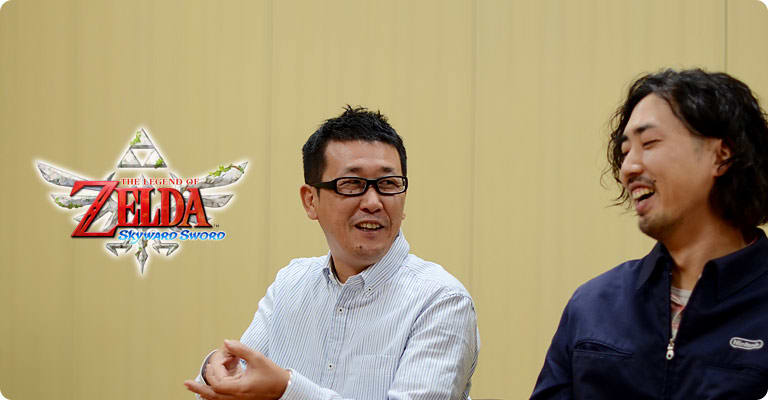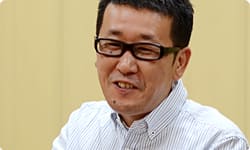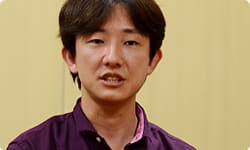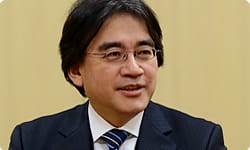You're Not Adventuring Alone
How did that trusty aide named Fi come about?
A sidekick is necessary in the Legend of Zelda series.
In a game where you do so much, I suppose it is asking a little much to expect the players to figure everything out and discover everything on their own without a sidekick.
And Link doesn't talk, so Fi was absolutely necessary to represent Link's emotions and explain the vast world of the game. And while keeping her function as a sidekick, we made her to be a character with personality like never before so she would mesh with the script.
When Link calls forth Fi, she offers hints and advice.
Yes.
Oyama-san, what impression did you have of the way Fi was portrayed?
I played through it all once when all the various areas were done to a certain degree. It didn't feel much as if Fi and I were on an adventure together.
Fi didn't feel like a partner. After all, she speaks so objectively.
Yes. (laughs) Link has no idea about the game fields he is going to journey through, but Fi knows all kinds of things about the game world, about the forest and volcano and so on, so she functions as a sort of navigator. As touched upon earlier, we made the game divided up into a forest team and a volcano team and so on, so the connections between the various game fields were lacking.
I suppose everyone was concentrating so hard on making each area densely packed with content that they had little thought to spare for those connections.
I think so. Then we made it so that when you first entered a new field, like the volcano, Fi would explain it up front, telling you what kind of place it was and offering warnings accordingly. We emphasized how Link is not alone on his adventure.
If you can do a good job saying, "You're not adventuring alone," does that change the way the game feels to play?
Absolutely. When you're in trouble, Fi doesn't just offer up hints. Rather, events occur that make you realize how important she is to Link. She's also involved in the story, but I shouldn't say any more.
The reason I asked Oyama-san to work on those connecting elements was because when each area was taking shape, I noticed that the connections between the various areas weren't very good. Just when I was looking around for someone to fill in the gaps, he was coming up with good ideas rather frequently, so I asked him to be the "gang leader*" in connecting all the areas. (*Editor's note: The original word used here is "bancho", typically a title given to a leader of a high school gang.)
Gang leader? (laughs)
I call it the "gang leader system." Toward the end, when I couldn't handle all the work or when things are beyond my ability, I appointed "gang leaders" to polish it up.
Someone in charge of a dungeon is polishing up the dungeon he made as hard as he can, so he isn't thinking about connecting the gaps. So each day I would play what was done, and if I felt someplace was a little thin, I would offer my opinion right away and come up with my own solutions.
Fi's messages focusing on each area were written by planners, so differences in Fi's verbal mannerisms arose. I made them all sound coldly logical, and where they were lacking, I wrote additional text. Right after I made Oyama-san the gang leader for establishing connections between the areas, he would say, "This message lacks something," and I started doing more of that work.
Fujibayashi-san wrote a ton of messages! Later on, when I played through from the beginning and saw those places where Oyama-san had made connections, I thought, "Oh, I see. That's how they're connected."
All the worlds created by the various teams linked together perfectly.
I believe so.
I also appointed Oyama-san as a gang leader to handle entrances to dungeons.
Oh, yes. In our last session of "Iwata Asks," you said that you wanted somehow to recreate the way Link went into dungeons in the original game, The Legend of Zelda.4
Yes. 4. The Legend of Zelda: An action-adventure game released simultaneously with the Family Computer Disk System in February 1986. The North American version was released for the Nintendo Entertainment System in August 1987.
Oyama-san, you were the one who fulfilled Fujibayashi-san's request to recreate that tump-tump-tump sound, weren't you?
Yes. Until now, the effect wasn't much different than going through a normal door, but this time he wanted me to recreate that feeling in the original Legend of Zelda of going into a dungeon. But even if we did it exactly the same way…
It wouldn't work.
No. But I decided to try it that way once and had the footfalls go tump-tump-tump.
That's right.
But, as might be expected, it didn't suit this game's atmosphere at all.
It fit the visuals of the original Legend of Zelda game perfectly, but it must have been quite a task for you to come up with an effect or sound that perfectly fit the visuals this time, which are neither realistic nor like cel animation.
That's right. I thought there was a need when players first enter a dungeon to tell them what kind of place it is and build up their excitement. For example, when you enter the volcano dungeon, there's an effect like a wall of heat hitting you.
Do you only see that effect when you first go into the dungeon?
Yes. From the second time on, there's an effect that conjures up that tump-tump-tump atmosphere from the original Legend of Zelda game.
We put a lot of effort into that. There was staff that specializes in cinematics and we asked them to work on the really particulars about every little detail, including the length, saying, "Make it a little longer," and "Make it shorter," right down to a few frames!
We adjusted the time until the fade down to a precise number of frames, like ten more frames here. As a result, however, I think we were able to effectively generate that atmosphere of entering into a dungeon.
I haven't seen that yet, so I can't wait for my second time to go into that dungeon! (laughs) It doesn't only apply to what we just talked about, but while this Legend of Zelda game has immense volume, you were thorough about addressing even the tiniest details. Why is that, do you think?
Maybe it's because we were able to pursue everything with such care.
The impression it makes does suggest extreme care.
I think one reason is the efficacy of the gang leader system. I have each person go beyond the confines of his or her own section with authority to address aspects of the whole production. That way we can be thorough and each person's responsibilities and roles are clear.



